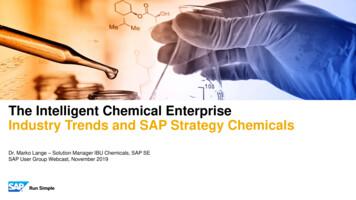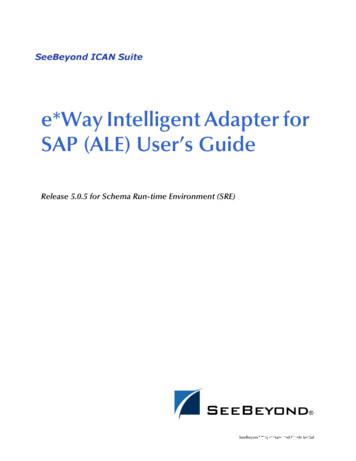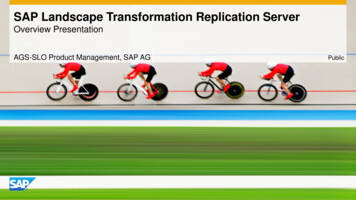Practical Guide To SAP Profit Center Accounting
Practical Guide to SAP Profit Center AccountingJohn Pringle
Table of ContentsPreface71 Introduction to profit center accounting1.111Business requirements for profitability management andreporting111.2PCA versus COPA121.3Evolution of profit center accounting171.4Summary202 Master data in PCA212.1Profit center212.2The dummy profit center302.3Profit center standard hierarchy312.4Profit center group342.5Revenue/cost elements and accounts372.6Account groups382.7Statistical key figures392.8Profit center assignment432.9Summary553 Planning in classic PCA573.1How profit center planning fits573.2Planning version concept in SAP593.3Integrated revenue and COGS planning603.4Integrated cost planning643.5Statistical key figure planning713.6Manual planning in classic PCA733.7Summary874 Profit center planning in the new GL4.1How new GL planning fits89895
TABLE OF CONTENTS4.2Planning version concept in new GL904.3Integrated revenue and COGS planning924.4Integrated cost planning in the new GL944.5Statistical key figure planning in the GL984.6Manual planning in the new GL984.7Summary5 Profit center actual postings1071095.1Flow of actual values in classic PCA1095.2Manual posting in classic PCA1215.3Flow of actual values in the new GL1235.4Actual statistical key figures1325.5Periodic processes1365.6Summary1366 Profit center transfer pricing1376.1Transfer pricing scenarios in SAP1376.2Transfer pricing setup1386.3Transfer pricing in practice1466.4Summary1507 Reporting in profit center accounting1517.1Reporting in classic PCA1517.2Profit center reporting in the new GL1617.3Report painter and drilldown options1657.4Summary173A The Author176B Index177C Disclaimer1806
2 Master data in PCAOne way of classifying data in SAP is to differentiate between itemsthat are considered master data and items that are considered transactional data. In SAP, master data is relatively static data that is usually defined once and is shared throughout the application. Examples include: vendors, customers, materials, general ledger accounts, cost centers, profit centers, etc. This master data is thenused in transactional data such as invoices, billing documents, andmaterial movements. In an SAP implementation project, the structureand definition of master data should be thoroughly planned toproperly reflect the needs of the business. Careful considerationshould be given to such factors as numbering and naming the master data, permitted field values, and the ultimate reporting aims of thebusiness. In this chapter, I show the relevant master data available inprofit center accounting.2.1Profit centerAs discussed in the previous chapter, the structure of the profit centers ismeant to define a responsibility reporting view of the organization. Oncethe master data is defined, the profit centers are arranged in a hierarchyto represent the responsibility structure of the enterprise. During the design of the system, the nature of that responsibility structure should bedetermined. Along what lines does the business divide itself? Is it on ageographical basis, a functional basis, a product line basis, some othermethod, or a combination of some of the above?Technically, the name of this hierarchy is defined first in the configurationsettings and assigned to the controlling area before the profit center masters can be created. This is the case for both classic PCA and for PCA inthe new GL. In classic PCA, it is also required to create a dummy profitcenter before you can start using the standard hierarchy. The concepts ofdummy profit center and standard hierarchy are discussed more fully inthe following sections.21
MASTER DATA IN PCAThe creation of the profit center master data is essentially the same regardless of whether you are using classic PCA or new GL PCA. Transaction KE51 is used to create profit centers (see Figure 2.1).Figure 2.1: Create profit center initial screenSet the controlling areaOften, when entering transactions in the controlling module in SAP, you are presented with a preliminaryscreen asking you to enter the controlling area. Havingto constantly enter the controlling area can become aggravating, especially when you may only be working withone area. The solution to this is to set your controlling area usingtransaction OKKS. Enter the controlling area that you work with andpress the SAVE button. The value is now stored in your user parameters and remains until you set it to a different value.It is important before you start creating pieces of master data, such asprofit centers, to understand how you are going to name or number them.Unlike some master data objects in SAP, profit center numbering is notdriven by a number range object. In fact, it is pretty much free form. Youare limited by the field size of up to 10 characters and there are a few special characters such as * that will be rejected; otherwise you can use anyalpha-numeric combination you choose. You should also be aware that the22
MASTER DATA IN PCAprofit center, like the cost center, exists in the controlling area, so it is notpossible to have a duplicate value within the same controlling area.Since your profit centers will be tied in some way to other organizationalobjects in SAP, such as company codes and cost centers, it is prudent tohave an overall numbering strategy for these objects before you startcreating them in the system. This should reflect the responsibility structure of the organization and be designed to facilitate reporting. Often, thestructure or the nature of your business will lead you to a certain strategyin profit center numbering: An organization with a primary focus on manufacturing may belargely concerned with results at a plant level, so may wish to reflect the plant structure somehow in the profit center numberingand hierarchy. An organization with a primary focus on re-selling may be moreconcerned with results at a regional or product line level so maywant to reflect that in the numbering and hierarchy.In the fictional example, you are setting up profit centers for an organization that manufactures and sells toys and games. They are interested inlooking at their results regionally. They operate in four regions; UnitedStates, Canada, Europe, and Asia. They are also interested in results byproduct line. These are: video games, board games, and card games.Copying master dataMany master data objects will have a COPY FROM orCREATE WITH REFERENCE option to allow you to use anexisting piece of master data as a template for your newentry. This can significantly speed up the creation ofnew pieces of master data.When you have decided on your profit center number, you can go aheadwith transaction KE51 (see Figure 2.2).The most important information about the profit center is contained onthe BASIC DATA tab.23
MASTER DATA IN PCAFigure 2.2: Create profit center basic dataThe profit center is considered to be a time-based object in controlling,which means it is created with a validity period and you can create different data for different time periods. In configuration, certain fields on themaster data can be flagged as time dependent, resulting in SAP storing anew master record whenever a time-dependent field is changed on aprofit center. The ability to create time-based objects is a very importantaspect of controlling since it allows you to view master data values atdifferent time periods. For example, the person responsible for the profitcenter may change next year. If person responsible is a time-dependentfield, then you will have a view of the profit center master when Sally wasthe person responsible, and then a new view starting when person responsible is reassigned.Defining time-dependent fieldsSince every change to a time-dependent field causesSAP to write a new master record for the data objectbeing changed, you should be very careful in definingfields as time dependent in the system configuration. Bydefining many time-dependent fields, the data volumescan become large and match-code searches can become confusingfor the user, as a piece of master data with more than one time rangewill appear multiple times in a match-code search. The SAP-deliveredconfiguration should be sufficient for most situations.24
MASTER DATA IN PCAThe time dependency of the profit center is checked when you createanother object with a relationship to it, such as a cost center. If you created your profit center to be valid from 01/01/2015 onwards, you will notbe able to create a cost center assigned to that profit center with a validfrom date earlier than 01/01/2015.Valid-from dates and other master dataIt is best to be aware of other master data requirementswhen you are setting up validity dates for profit centers,cost centers, and other CO objects. There may be requirements from other modules, such as HR or fixed assets, that the cost centers should exist for a certain timein the past to allow historical data to be loaded. It is good to know thatbefore you create your cost centers and profit centers to avoid a lot ofextra rework extending the validity periods after the fact.Other key fields on the BASIC DATA tab are person respons, this is theperson responsible for the results of the profit center. There is also userresponsible, which links to the user master in the SAP system. Thisfield is not mandatory since it is possible that the person responsible forthe profit center does not exist as a user in the SAP system. The department field is a free text field that can be used to store an externaldepartment number. There is no validation on the entry in this field, sothe user creating the profit center can enter any value they choose.The field profit ctr group makes the link between the profit centerand its place in the standard hierarchy. The profit center group selectedhere is a node in the hierarchy. In the initial setup of the profit centerstructure, there are several different approaches to populating this field. Ifyou are creating other master data, such as material masters which maybe dependent on a profit center number, you may want to load or createall the profit centers before you have fully thought out all the levels in thehierarchy. In this case, you may wish to create all the profit centers andassign them to the top hierarchy node and then distribute them later.Alternately, you may have your hierarchy in place and may choose todirectly assign each profit center to its correct level during the initial creation.25
INDEXB IndexADAccess sequence 141Activate plan integration forsecondary cost elements 97Activities 67Activity-Based Costing 46Actual SKF postings – Settings132Alternative hierarchies 34Assessment 69Depreciation and interestsimulation 70Distribution 69Distribution key 80Document splitting 125Drilldown reporting 168Basic Report 168Form Based 168Dummy profit center 30BEBalance sheet adjustment 116Business process 46Entry view 129CFIN PCA 18FIN SEGM 26Formula planning 84Classic PCA 17Accounts 37Activation 17Balance Sheet Accounts 110Balance Sheet Planning 80Copy Planned Data 83Flow of actual data 109P&L accounts 110Plan Allocations 82Plan Balance Carryforward 82Constant for unassignedprocesses 126COPACosting based 13Purpose of 12Revenue Planning 60Valuation 14Costing run 142Costing type 143Costing variant 142Costing versions 145FGGeneral ledger view 129Generic file 76GL Plan Copy 106Group valuation 137IIntegrated excel planning – Steps75Interactive reporting 152LLedger concept 90Legal valuation 137List-oriented reports 152177
INDEXMProduction Order 49Project Systems 45Repetitive Mfg 50Sales Order 50Through substitution 50Mandatory field 126NNew GL PCA 17Accounts 37Balance Sheet Planning 103Benefits 20Migration 19Planned CO allocations 95Planning Layouts 98SAP recomendations 19Scenarios 18Versions 90Profit center standard hierarchy31Profit center valuation 138RReference variant 144Report PainterBasic Structure 165Library 166Report Group 166OOnline transfer of data to PCA64PPlan Integrated Order 66Plan Integration-Projects 66Plan versions 59Planned allocations 67Planner profile 73Planning layout 73Pricing procedure 141Profit CenterActivate 30Business defintion 15Company code assignment 29Numbering 22Profit Center AccountingPossible situations 18Purpose of 12Profit Center AssignmentBusiness Process 46Cost Center 43Fixed Assets 52Internal Order 44Material Master 47Plant Maintenance 52178SS/4HANA 16Sales order substitution 50Segment 26Change value on profit center27Standard costing 142Statistical Key FigureDefinition 39Fixed value 41Totals value 41TTemplates 84Transaction 1KE4 – AssignmentMonitor 54Transaction 1KEK – Transferpayables and receivables 117Transaction 3KEH – AdditionalBS & P&L Accounts 111Transaction 7KEX – Upload fromexcel 77Transaction 9KE0 – Profit centerposting 121
INDEXtransaction F.50 – P&LAdjustment 120transaction F.5D – Balance sheetadjustment 116Transaction GLPLUP – Uploadfrom Excel 102Transaction KCH1 – Create profitcenter group 34Transaction KCH1 – Createstandard hierarchy 32Transaction KCH5N – Changestandard hierarchy 32Transaction KDH1 – Createaccount groups 38Transaction KE1V – Trasfer plandata from COPA 61transaction KE1Z – TransferCOPA Plan to GL 92Transaction KE51 – Create ProfitCenter 22Transaction KE59 – DummyProfit Center 31Transaction KK01 – Createstatistical key figure 40Transfer control 144VVariation 157WWIP calculation 113ZZero balance 125179
Practical Guide to SAP . 1.3 Evolution of profit center accounting 17 1.4 Summary 20 2 Master data in PCA 21 2.1 Profit center 21 2.2 The dummy profit center 30 2.3 Profit center standard hierarchy 31 2.4 Profit center group 34 2.5 Revenue/cost elements and accounts 37 2.6 Account groups 38 2.7 Statistical key figures 39 2.8 Profit center assignment 43 2.9 Summary 55 3 Planning in classic .
SAP ERP SAP HANA SAP CRM SAP HANA SAP BW SAP HANA SAP Runs SAP Internal HANA adoption roadmap SAP HANA as side-by-side scenario SAP BW powered by SAP HANA SAP Business Suite powered by SAP HANA Simple Finance 1.0 2011 2013 2014 2015 Simple Finance 2.0 S/4 HANA SAP ERP sFin Add-On 2.0
SAP Certification Material www.SAPmaterials4u.com SAP Certification Material for SAP Aspirants at Low cost Home Home SAP Business Objects SAP BPC CPM SAP BPC 7.0 SAP EWM SAP GTS SAP Public Sector SAP Real Estate SAP FSCM SAP FI/CO SAP AC - FI/CO SAP BI 7.0 SAP CRM 5.0
SAP Master Data Governance SAP Information Steward SAP HANA smart data integration SAP Data Hub SAP Cloud Platform Big Data Services SAP HANA, platform edition SAP Vora Customer Experience IoT Workforce Engagement SAP Cloud for Customer SAP Commerce SAP Marketing SAP Asset Intelligence Network SAP Predictive Maintenance and Service SAP .
ALE/RFC Setup 88 SAP System Type 88 SAP IDoc Version 88 Program ID (SAP to e*Gate) 88 SAP Load Balancing Usage (e*Gate to SAP) 89 SAP Application Server (e*Gate to SAP) 89 SAP Router String (e*Gate to SAP) 90 SAP System Number (e*Gate to SAP) 90 SAP Gateway Ho
SAP HANA Appliance SAP HANA DB In-Memory A io BI Client non-ABAP (SAP supported DBs) SAP Business Suite SAP Business Suite SAP Business Suite SAP Business Suite SAP Business Suite SAP Business Suite SAP Business Warehouse SAP HANA DB r In-Memory Source Systems SAP LT Replication Ser
Customer Roadmap to SAP Simple Finance - Example " Adopting SAP Simple Finance is a journey - start early" Side-by-side SAP HANA Acceleration SAP HANA accelerators, BW, BPC, GRC SAP Business Suite on SAP HANA SAP ERP on SAP HANA SAP ERP in SAP HANA Enterprise Cloud SAP Accounting Powered By SAP HANA Simple Finance add-on/
SAP Business Suite SAP BW SAP Apps Partner Apps SAP HANA PLATFORM Planning and Calculation Engine Real-Time Replication Services Information Composer & Modeling Studio SAP UI HTML5 Mobile SAP BI 4 SAP ERP SAP CRM SAP SCM SAP PLM SAP SRM SAP Netweaver Predictive Analytics & Business Function Libraries In-Memory
Sep 28, 2021 · SAP LLC “SAP Labs“ MEE Russian Federation SAP SAP CIS, LLC MEE Serbia SAP SAP West Balkans d.o.o. MEE Slovakia SAP SAP Slovensko s.r.o. MEE Slovakia SAP Ariba Ariba Slovak Republic, s.r.o. MEE Slovenia SAP SAP sistemi, aplikacije in produkti za obdelavo podatkov d.o.o. MEE Switzerland Emarsys Emarsys Schweiz GmbHFile Size: 598KB























